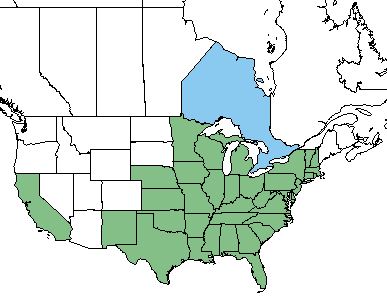Difference between revisions of "Tridens flavus"
| Line 1: | Line 1: | ||
{{italic title}} | {{italic title}} | ||
| + | Common name: redtop <ref name= "Weakley 2015"/>, tall redtop <ref name= "Weakley 2015"/>, purpletop tridens <ref name= "Weakley 2015"/>, greasy grass <ref name= "Weakley 2015"/>, Chapman's tridens <ref name= "USDA Plant Database"/> | ||
<!-- Get the taxonomy information from the NRCS Plants database --> | <!-- Get the taxonomy information from the NRCS Plants database --> | ||
{{taxobox | {{taxobox | ||
Revision as of 12:33, 12 June 2018
Common name: redtop [1], tall redtop [1], purpletop tridens [1], greasy grass [1], Chapman's tridens [2]
| Tridens flavus | |
|---|---|

| |
| Photo by John Gwaltney hosted at Southeastern Flora.com | |
| Scientific classification | |
| Kingdom: | Plantae |
| Division: | Magnoliophyta - Flowering plants |
| Class: | Liliopsida - Moncots |
| Order: | Poales |
| Family: | Poaceae |
| Genus: | Tridens |
| Species: | T. flavus |
| Binomial name | |
| Tridens flavus (L.) Hitchc. | |

| |
| Natural range of Tridens flavus from USDA NRCS Plants Database. | |
Contents
Taxonomic Notes
Synonyms: none
Varieties: none
Description
T. flavus is a perennial graminoid of the Poaceae family native to North America and introduced to Canada. [2]
Distribution
T. flavus is found in the eastern half of the United States as well as California, and in the Ontario region of Canada. [2]
Ecology
Habitat
T. flavus proliferates in roadsides, disturbed areas, and glades. [1]
Phenology
T. flavus flowers in October. [3]
Fire ecology
T. flavus is not fire resistant, but has high fire tolerance. [2]
Use by animals
T. flavus has high palatability for grazing and browsing animals. [2]
Conservation and Management
Cultivation and restoration
Photo Gallery
References and notes
- ↑ 1.0 1.1 1.2 1.3 1.4 Weakley, A. S. (2015). Flora of the Southern and Mid-Atlantic States. Chapel Hill, NC, University of North Carolina Herbarium.
- ↑ 2.0 2.1 2.2 2.3 2.4 USDA Plant Database https://plants.usda.gov/core/profile?symbol=TRFL2
- ↑ PanFlora Author: Gil Nelson URL: http://www.gilnelson.com/PanFlora/ Date Accessed: 5/29/18